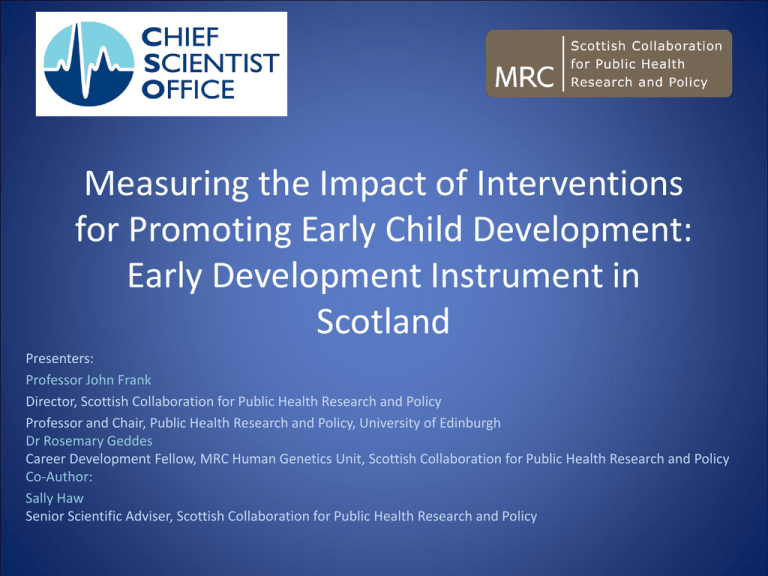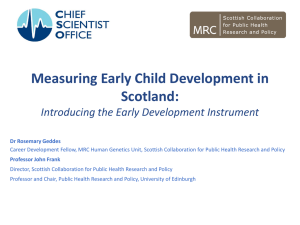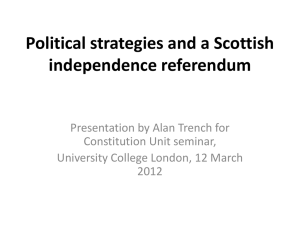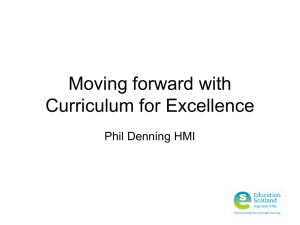EDI HeadTeachers_conference_26Jan
advertisement

Measuring the Impact of Interventions for Promoting Early Child Development: Early Development Instrument in Scotland Presenters: Professor John Frank Director, Scottish Collaboration for Public Health Research and Policy Professor and Chair, Public Health Research and Policy, University of Edinburgh Dr Rosemary Geddes Career Development Fellow, MRC Human Genetics Unit, Scottish Collaboration for Public Health Research and Policy Co-Author: Sally Haw Senior Scientific Adviser, Scottish Collaboration for Public Health Research and Policy Interventions for Promoting Early Child Development for Health (July 2010)* *Downloadable at: www.scphrp.ac.uk WHAT IS THE KEY PUBLIC HEALTH PROBLEM IN SCOTLAND? •Lifelong health and functional inequalities, by socio-economic status, that are NOT improving in Scotland •Dysfunctional bottom 10-20% of population: not competitive in global economy, and very costly to for the public purse to “carry,” lifelong Absolute range: Healthy life expectancy, Males – Scotland 1999- 2006 (Data not available 2003/04) Source: Scottish Government Health Analytical Services (2008) Long-term monitoring of health inequalities (updated in September, 2009, but very few changes in long-term trends) Absolute range: Healthy life expectancy, Females Scotland 1999-2006 (Data not available 2003/04) Source: Scottish Government Health Analytical Services (2008) Long-term monitoring of health inequalities Source: Power C, Mathews S. Origins of health inequalities in a national population sample. Lancet 1997: 350:1584-89. Life-Course Health Problems Linked to Inadequate Early Life Nurturing 2nd Decade 3rd/4th Decade • School Failure • Obesity • Teen Pregnancy • Elevated Blood Pressure • Criminality • Depression • Addictions Source: Clyde Hertzman, Early Child Development: A powerful equalizer. 5th/6th Decade Old Age • Coronary Heart Disease •Premature Aging • Diabetes • Memory Loss WHAT DETERMINES THESE OUTCOMES? The cumulative effect of genetics, prenatal life, and post-natal environmental factors – especially love, skilled parenting, cognitive stimulation and social role-modelling, in a positive society – most of which is strongly set in motion before age 5 `Sensitive periods’ in early brain development “Pre-school” years High School years `Numbers’ Peer social skills Conceptualization Language Habitual ways of responding Emotional control Vision Hearing Low 0 1 2 3 4 Years 5 6 7 Graph developed by Council for Early Child Development (ref: Nash, 1997; Early Years Study, 1999; Shonkoff, 2000.) The gradient worsens in usual education… because it starts too late. Source: Fairer Society, Healthy Lives. The Marmot Review.2010. Determinants of School Outcomes in Scotland – Why Schools Are Not to Blame • “While individuals may defy this trend, no school in a deprived area is able to record a similar level of success to that achieved by almost all schools in the most affluent areas.”¹ • “...but the gaps between them (schools) are far less important than differences between students. In Scotland, who you are is far more important than what school you attend.”² 1. 2. Literacy Commission. A Vision for Scotland: The Report and Final Recommendations of the Literacy Commission. Scottish Labour, December 2009. http://www.scottishlabour.org.uk/literacy OECD. Quality and Equity of Schooling in Scotland. Paris: OECD, 2007. Can we influence this? Source: Sloat E, Willms JD. The International Adult Literacy Survey. Literacy Scores for Youth Aged 16-25 years (Statistics Canada & the OECD, 1995). How can this be influenced? •Increase or redirect resources to early years •Detailed plans/strategies required for the implementation of the Early Years Framework. Central guidance based on scientific evidence is required in programme design, implementation & evaluation. •Early childhood development programmes to equitably address cognitive & behavioural development should be adopted. •Robust methods to identify pregnant women and infants at high social and developmental risk are necessary if targeted approaches are to be adopted. •Programmes should provide a seamless continuum of care and support from pregnancy through to school entry. Source: SCPHRP Environmental Scan, July 2010, page 62 – downloadable at www.scphrp.ac.uk “No Data, No Problem, No Action” Alfredo Solari • Data to monitor children’s development and functioning in the Scottish population, and the effectiveness of related programmes, are lacking – every local area does its own thing. • More early-stage measures are needed as well as better latestage measures (e.g. mental health), which would require data linkage. These measures should span developmental milestone attainment via standardized assessments (collected in the primary health care system, and (ideally) by home visitors, Child Centre/nursery staff) with an overall “school readiness” assessment around school entry. • All these data need to be collated and analysed centrally to reveal patterns of “unmet need” – for appropriate resource allocation -- in child development by geographic, ethnic and socioeconomic position. What is the EDI? • The EDI is teacher-completed (20 minutes) checklist that assesses children’s readiness to learn when they enter school. • As a result, the EDI is able to predict how children will do in primary school. • In other words, it measures the effects of all children’s pre-school (0-5 years) experiences as they influence readiness to learn at school– and thus assist communities to improve local pre-school programmes. What Does the EDI Measure? A Population-Based Measure • The EDI is designed to be interpreted at the group level. • The EDI does not provide diagnostic information on individual children – schools do that already, but not community-level assessment to guide preschool action . What the maps reveal… • Large local area differences in the proportion of developmentally vulnerable children: typically 10% to 50 % range • The high proportion of avoidable vulnerability – i.e. not biologically predetermined, but rather preventable by improving children’s home and community learning environments • The degree to which socioeconomic context explains and does not explain variations in early development: room for hope! • Which communities are doing better or worse than predicted: prompts the study of ‘why’ and learning between communities • Change over time – so that community preschool programme improvements can be evaluated Case study: Mirrabooka community, Western Australia • Part of the Australian’s Government’s “Communities for Children (C4C)” • First in Australia to have undertaken the AEDI four times (in 2003, 2004, 2008 and 2009) • Community have been able to use their AEDI results to inform and implement change including supporting the planning of C4C • Asset mapping exercise: positioning of community infrastructure – e.g. parks, libraries, playgroups, child health centres – compared to the AEDI results, to inform planning in relation to need Case study: Mirrabooka community, Western Australia • Planning and implementation of C4C initiatives: projects focussed on early literacy, child health, community networking, increasing the social cohesion between schools and communities through the implementation of programs such as FAST (Families and Schools Together), and programs which support home to school transition • Supporting applications for the funding of projects that helps address areas of vulnerability identified Source: http://training.aedi.org.au/Secondary-Pages/About-the-video-casestudies/Mirrabooka-Community-Western-Australia.aspx Asset Mapping Perth East Metropolitan region, Proportion of children vulnerable on one or more domains Muchea Muchea Bullsbrook Bullsbrook Proportion of children vulnerable N=Percent 34.4 to 63.9 24.5 to 34.3 18.5 to 24.4 10.5 to 18.4 0 to 10.4 Gidgegannup Gidgegannup The The Vines Vines Upper Upper Swan Swan Belhus Belhus Ellenbrook Ellenbrook Darch Darch Henley Henley Brook Brook Alexander Alexander Heights Heights Marangaroo Marangaroo Ballajura Ballajura Girrawheen Girrawheen Koondoola Koondoola Balga Balga Mirrabooka Mirrabooka Westminster Westminster Herne Herne Hill Hill Beechboro Beechboro Morley Morley Mount Mount Hawthorn Hawthorn North North Perth Perth Stoneville Stoneville West West Swan Swan Middle Middle Swan Swan Jane Jane Brook Brook Stratton Stratton Caversham Caversham Lockridge Swan View View Lockridge Midland Midland Swan Eden Eden Hill Hill Woodbridge Woodbridge Greenmount Greenmount Guildford Guildford South South Guildford Guildford Helena Helena Valley Valley Parkerville Parkerville Chidlow Chidlow Mount Mount Helena Helena Hovea Hovea Mahogany Mahogany Creek Creek Glen Glen Forrest Forrest Mundaring Mundaring Darlington Darlington Sawyers Sawyers Valley Valley Highgate Highgate East Metropolitan Perth, WA Prepared by: AEDI National Support Centre Source: AEDI Communities Data 2004/05 The AEDI community planning process 1. Identifying areas of particular need 2. Assessing the local distribution of children’s developmental vulnerability e.g. Mission Australia funds 3 year play group, language program & mums group at school 3. Community asset mapping 4. Mobilising community action Mirrabooka C4C - Change in AEDI Results from 2003-2009 60 Proportion of Children Vulnerable 50 40 Phys 30 Soc Emot Lang Comm 20 Low 1+ 10 0 2003 (n=538) 2004 (n=354) 2008 (n=228) Year 2009 (n=589) EDI pilot in Scotland led/funded by SCPHRP - main objectives • Adapt Canadian EDI to Scottish context and school system • Implement in at least one local authority: East Lothian 2011 • Link mean scores in each developmental domain to socioeconomic status • Determine % ‘vulnerable’ children in each developmental domain, and overall • Generate reports, present results to stakeholders in LA & to Scottish Government, using user-friendly charts & maps • Validate results, if possible, against Durham Uni’s PIPS • Provide data to Information Services Division for potential anonymous linking with routinely collected data such as maternal records and health visitor reports When, who, and how much? 2 phases: Phase Purpose Who When 1 Test EDI tool for content, language, acceptability 20 P1 teachers* March will each 2011 complete EDI for 11 children 2 Implementation of EDI to determine level of child development in population All P1 teachers will complete EDI for all their P1 pupils Cost Funds for supply teachers for ½ day training & full day to complete EDI November Training during 2011 October in-service day & teacher time allocated for EDI completion *4 teachers from each Musselburgh and Prestonpans; 3 teachers from each Tranent, Haddington, North Berwick and Dunbar Proposed timelines • 7-11 February: Education cluster meetings in East Lothian where 20 P1 teachers will be identified • 28 Feb and 2 March: teacher training half days • Mon 21 Feb: Parent information sheets are distributed • Mon 7 March-Friday 18 March: 2 weeks for P1 teachers to complete EDI tools for 11 children each • 21 March for two weeks: ADS will do data entry • 4 April: beginning of data analysis (Strathclyde) of 220 EDI questionnaires & teacher demographics Proposed timelines • 5 May: East Lothian Project Implementation Team would like 'initial feed-back' on the process • Mid-October: Training for approximately 60 P1 teachers • Mid to end November: EDI completion for approximately 1200 P1 pupils • December data entry • Beginning January: Data analysis Strathclyde starts 1200 EDI questionnaires • Spring 2012: Results presented CONTACT & TRAINING DETAILS Rosemary.geddes@hgu.mrc.ac.uk Names of 20 nominated P1 teachers & their schools, cluster and an email address/contact details for the teacher sent to me by end of Friday 11 February. Training: Musselburgh - Monday 28 Feb 09h00-12h30 Haddington - Wednesday 2 March 09h00-12h30 Useful websites & references • Scottish Collaboration for Public Health Research and Policy: www.scphrp.ac.uk • Offord Centre for Child Studies http://www.offordcentre.com/index.html • Australian Early Development Index - click on AEDI http://www.rch.org.au/ccch/index.cfm?doc_id=10556 • British Columbia ECD mapping portal http://www.ecdportal.help.ubc.ca/archive/faq.htm • Hertzman C, Williams R. Making early childhood count. CMAJ. 2009 Jan 6;180(1):68-71. • Lloyd JEV, Hertzman C. From Kindergarten readiness to fourth-grade assessment: Longitudinal analysis with linked population data. Social Science & Medicine. 2009;68(1):111-23. • Hertzman C. Tackling inequality: get them while they’re young. BMJ 2010; 340:346-8 • Marmot M. Fair Society, Healthy Lives. London: University College London; 2010.











